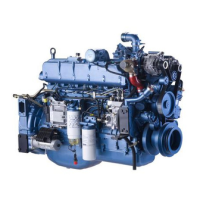Weichai America Corp.
Revision: October 2018 18
C. If coolant level is low, determine reason for low fluid and top off with specified
coolant.
D. Test pressurized cap (replace if necessary or reinstall).
3. Check Oil Pressure
A. When engine is running and at normal operating temperature, check oil pressure
gauge.
i. Some engines will have an analog gauge and others will have an electronic
gauge from the ECU.
B. Ensure oil pressure is in the range of the table below both at idle and rated speed
and operating temperature.
Oil Pressure
Idle PSI kPa
Min 19 >130
Rated Speed
Min 50 350
Max 84 580
Table 3
4. Check Overall Operating Condition
A. Inspect hoses, pipes and clamps for loose connections or leaks.
B. Check the belt for fraying or damage.
C. Look for fluid leaks under and around the engine.
D. Inspect ignition wires and system for routing and connections.
E. Inspect the engine harness for corrosion, abrasions, cuts or shorts.
F. Look around engine for any debris or loose materials that might become a hazard.
G. Assure battery voltage is ≥12v each and terminal connections are clean and
tight.
5. Change Oil and Oil Filter
Materials:
Materials QYT
Oil 27L~32L; see dipstick
Oil filter 2
Table 4
NOTE: Recommended oil are: Natural Gas Engines Oil (NGEO); CI-4 or above.
NOTE: For continuous operation in extreme temperatures or in excessively dusty, dirty
environments, rely on oil analysis to determine maintenance intervals.
NOTE: For best results, change engine oil while engine is still warm from operation.
A. Remove the oil pan drain plug and drain oil completely.
Document Courtesy of Fly Parts Guy Co.
www.FlyPartsGuy.com
Document Courtesy of Fly Parts Guy Co.
www.FlyPartsGuy.com

